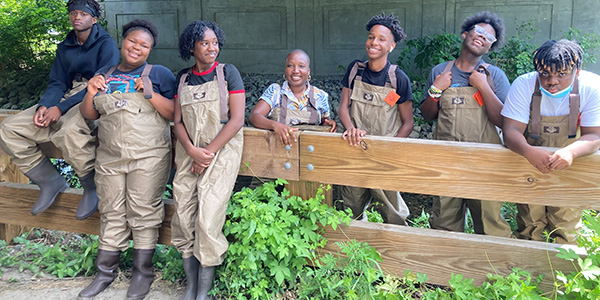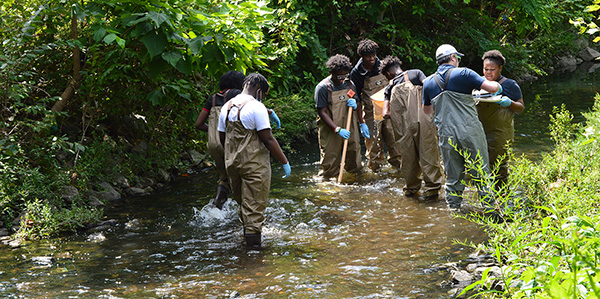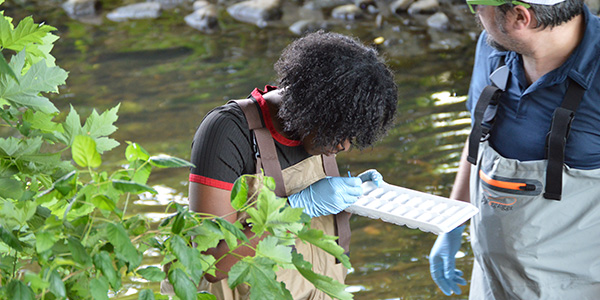
The waders did not go over well.
A couple of the half-dozen teenagers gearing up on the sidewalk of the East 3rd Street Bridge connecting Mount Vernon and Pelham struggled to tell the front from the back of their uniforms du jour. Every last one of them objected to the fashion misstatement made by this unflattering cross between mud brown footie pajamas and a roomy wetsuit. One student wondered whether she should wear a mask – not because she was concerned about a virus; she was mortified at the prospect that a photo of her wearing waterproof overalls would go viral.
The waders, though, were non-negotiable. They provided an important protective layer for the students spending part of their Wednesday morning in the unhealthy waters of a stretch of the Hutchinson River directly beside its namesake parkway. The students, participants in the Environmental Leaders of Color summer STEM program, would be collecting macroinvertebrate samples to help determine the water quality of this neglected waterway bordering their community.
“The goal with this kind of project is to get community members out in their local environment, not just for a nice outing but also to take some data that will be used,” said Sam Marquand, our clean water advocacy specialist, who followed up a classroom session in which he introduced students to water quality testing with this summer day in the field.

Or, more specifically, in the water. They walked 50-yard sections of the river, kicking over rocks to scatter whatever might be living under them. Different organisms thrive in different conditions, so knowing which species are present can indicate a lot about water quality.
The students used a net to catch whatever they’d disrupted from the riverbed, poured the contents into a tray, then sorted through to separate critters from the stones and silt and placed single representative samples of the various species they found into ice trays. Sam will ship those samples to New York’s Department of Environmental Conservation as part of its 11th-annual WAVE program (Water Assessments by Volunteer Evaluators). DEC will use those them to determine whether this stretch of the Hutchinson River should be listed as “impaired.”
Based on the findings from last summer’s outing with a different youth organization from Mount Vernon, Sam knew what to expect when he led this year’s contingent down the rocky slope and into the shallow waters of the Hutch.
“We found freshwater clams, a lot more this year and a lot bigger this year. There were a lot of leeches, midge larvae, some fly larvae. We found a crayfish, which we didn’t find any of last year,” said Sam. “None of them were the kind of ‘most-wanted’ critters that you’d see in a healthy river, which wasn’t surprising.”

That’s really the reason for doing outings in locations like this one, beneath a bridge over troubled waters. Once the health of a river can be documented, the causes of its problems can begin to be addressed. And when those data can be gathered by community members, it creates other opportunities as well.
“One of the objectives of Environmental Leaders of Color is to have students learn about the environment and start to think about what they can do, what are the solutions and how can they apply them to their local community,” said Natacha Robert, who is supervising this cohort through the summer curriculum, ‘Water: So Many Possibilities.’ “We want to make sure that students live their education. Once they learn about something in the classroom, they should be able to go out and experience it. It’s important to marry the two.”
Clearly, the students would agree. Once they got beyond the initial waders drama, they relished their time in the water, punctuated by the predictable “eeeews” and “whoas” of teenagers handling live creepy-crawlies.
“It was even better than I expected. I wish we could’ve stayed in there a little longer,” said Celso DaSilva, a rising junior at Mount Vernon High School, who seemed most interested in an eel they spotted and released. “It was fun to get to actually experience it and not just envision it. We wouldn’t have as much interest in it unless we participate in the actual physical activity.”
